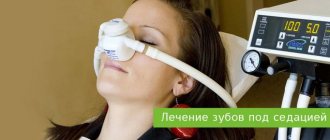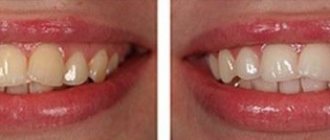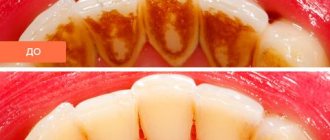Local anesthesia in dentistry: types and preparations
In therapeutic and surgical dentistry, various types and techniques of pain relief are used. These include conduction, intracanal, intraligamentous, etc. They differ in the place of application of the anesthetic and the characteristics of administration, as well as the duration of the effect.
In modern dental clinics, carpule anesthesia is used: the anesthetic is supplied in disposable carpules - cartridges in which painkillers are mixed in the required proportions. They are inserted into syringes with screw-on disposable needles. This makes it possible to ensure sterility, since the doctor does not need to open the containers - contact of the drug with air is excluded.
Conductor
Conduction anesthesia is designed to temporarily block the nerve that transmits the pain signal. This makes it possible to numb several teeth at once, since the sensitivity of a certain area of the jaw is lost. This type of anesthesia is used in cases where it is necessary to remove or treat 2-3 teeth located nearby. It is also used for operations on soft tissues. This anesthesia lasts for at least one and a half hours.
Application anesthesia
Application anesthesia is a type of non-injection anesthesia. Apply the product with your finger or a cotton swab to the selected area. Absorbing into soft tissues to a depth of 3 mm, the medicine can reduce their sensitivity for a short period of time. Most often, this method is used to make the injection painless.
There is another form of drug release - in the form of an aerosol. However, such drugs are used less frequently because there is a possibility of inhalation and the components entering the bloodstream.
Infiltration
There are two types: direct (introduction of the drug under the mucous membrane near the teeth), indirect (introduction into the surrounding tissues). In the first case, the effect is more local, in the second, a larger area is anesthetized.
Infiltration anesthesia is often used for the teeth of the upper jaw. The alveolar processes have a less dense structure, so anesthesia is effective within one hour. In most cases, this is quite enough to perform many procedures, such as treating deep caries, filling root canals, etc.
Intraligamentary
It is also called intraligamentous. This anesthesia differs in that when administering the drug, the doctor applies more pressure so that the drug can be distributed in the periodontal tissues and penetrate into the intraosseous space. This type of pain relief begins to work in less than a minute. However, its effect is short-lived: up to 30 minutes. The administration of the medicine is practically painless, and there is no numbness of the soft tissues. Intraligamentous anesthesia can be used for the extraction and preparation (grinding) of teeth.
Spongy
Also called intraosseous anesthesia, one of the most complex types. It is used when other methods demonstrate ineffectiveness or are impossible. Allows you to anesthetize the process of removing molars and perform interventions on the alveolar processes. The doctor first dissects the mucous membrane and makes a small hole in the bone tissue using a dental bur. Afterwards, a needle is inserted into it, and the anesthetic medicine is supplied to the spongy substance of the jaw. This anesthesia lasts for up to one hour.
General anesthesia in dentistry
General anesthesia in dentistry is used when long-term, serious treatment is necessary. This solution is relevant in cases that require the removal of several teeth at once, or complex interventions on the jaw. An indication for the use of anesthesia can also be a strong fear of the dentist and the upcoming manipulations. It is also advisable to resort to anesthesia if the patient cannot adequately interact with the doctor, for example, in the presence of a neuropsychiatric disease, epilepsy, etc.
An alternative to anesthesia is sedation: it can be used as a way to improve mood, relieve anxiety, and get rid of the fear of medical manipulation. The patient is conscious, but half asleep. Sedation promotes calm, psycho-emotional balance, and normal perception of the specialist’s actions. But this is not pain relief, so this method is combined with local anesthesia.
What is anesthesia
What is general anesthesia?
General anesthesia (previously called anesthesia) is an artificially induced reversible state similar to deep sleep, in which any (including pain) sensations are suppressed and the patient’s consciousness is turned off, and the muscles of the body are relaxed. The patient does not remember what happened during anesthesia. This condition is maintained by an anesthesiologist during surgery by administering certain drugs for anesthesia (anesthetics). As a rule, after performing premedication in advance (most often this is taking sedatives), general anesthesia begins with the administration of a fast-acting hypnotic medication through a venous catheter installed in a peripheral vein for the administration of drugs and solutions.
General anesthesia can be maintained in different ways:
- repeated or continuous administration of drugs through a venous catheter (intravenous anesthesia). In total intravenous anesthesia, the anesthetic agent is administered exclusively intravenously and no vaporized anesthetic or gas is added to the respiratory mixture. An anesthesiologist-reanimatologist will tell you in more detail about this anesthesia.
- using a mask that is applied to the mouth and nose area (general anesthesia with a face mask).
- using a laryngeal (laryngeal) mask, which is passed through the mouth, located in the pharynx and covers the entrance to the larynx, or
- using a breathing tube that is placed through the mouth into the airway (trachea) (general anesthesia with artificial ventilation through a tube installed in the trachea).
In the last three cases, an inhalational anesthetic is used. A common property of inhalational anesthetics is the ability to be removed very quickly through the lungs from the body, which promotes rapid awakening after anesthesia and less depression of consciousness (drowsiness, lethargy) on the first day after anesthesia. Most often, both intravenous and inhalational anesthetics are used simultaneously (combined general anesthesia).
Air and/or oxygen and, if necessary, vaporized anesthetic will be supplied through a breathing mask, laryngeal mask, endotracheal tube. The use of masks and tubes also allows artificial respiration using an anesthesia-respiratory apparatus, which is necessary for complete muscle relaxation (muscle relaxation during surgery), since the main respiratory muscle, the diaphragm, also relaxes. Anesthesia with tracheal intubation reduces the risk of saliva or dangerous acidic stomach contents being refluxed into the lungs (aspiration). The laryngeal mask and endotracheal tube are used only when you are already in a state of general anesthesia, to maintain patency of the airways, since the patient’s spontaneous breathing is impaired to some extent during anesthesia. A muscle relaxant (muscle relaxant) is required to pass the tube and possibly place a laryngeal mask airway.
End of anesthesia
At the end of the surgery, the anesthetic is stopped and you slowly emerge from the anesthesia, as if waking up from a deep sleep. Next, the anesthesiologist monitors you and, if your vital signs are stable, consciousness is restored and there are no life-threatening conditions, you will be transferred back to the department. After long and difficult surgical procedures, transfer to the intensive care unit for intensive observation and treatment may be required. To protect against falls and injuries in the immediate postoperative period, restriction of physical activity may be required, namely the use of side bars of the bed and soft fixation of the limbs.
Local anesthesia
With local anesthesia, a painkiller is injected directly into the surgical area (performed by surgeons). With regional anesthesia, the anesthetic is administered at a distance from the intervention site near the nerves innervating the surgical field. In this case, pain sensitivity of the anesthetized part of the body is blocked for a certain time, motor activity is temporarily turned off or limited. Unlike general anesthesia, the patient remains conscious and accessible to contact, but there is no pain. These methods of anesthesia also require the anesthesiologist to closely monitor the patient's condition and vital signs, as with general anesthesia. If necessary, the patient additionally receives a mild sedative or sleeping pill. This may limit memories of the surgery. Depending on the circumstances, strong painkillers are additionally administered.
During regional anesthesia, the anesthetic can be administered once, repeatedly or continuously through a thin catheter.
Regional anesthesia techniques.
Spinal anesthesia
The numbing agent is injected through a thin needle that is passed from the area of the lower back between the vertebrae to the subarachnoid space (surrounding the spinal cord). Next, the local anesthetic is mixed with the cerebrospinal fluid (a clear liquid that fills the subarachnoid space), blocking the pain impulses along the nerves that transmit the pain signal to the spinal cord. The needle is removed. The effect of the medicine begins almost immediately after the injection and lasts for several hours. The amount of local anesthetic is minimal.
Epidural anesthesia
In the back area, a thin catheter is passed through a hollow needle into the epidural space (located outside the spinal canal, which contains the spinal cord, which in turn is surrounded by the spinal space). The needle is removed. Next, the doctor administers the medicine through a catheter. It spreads through the epidural space in the area of passing nerves, blocking pain, anesthetizing a specific region of the patient’s body. Depending on the type of surgical intervention, the medication is administered at the level of the thoracic or lumbar spine. The effect of painkillers begins within 15-30 minutes and lasts for several hours. This type of anesthesia is successfully used to relieve pain in patients in the postoperative period, since a once installed catheter allows repeated administration of a local anesthetic (up to 5 days). This type of anesthesia requires a larger amount of anesthetic.
Unfortunately, regional anesthesia methods do not always allow for complete relief from pain, therefore, in such cases, surgery is performed under general anesthesia. For certain operations, a combination of regional and general anesthesia is used. In this case, less anesthetics are required, the patient awakens faster, and pain in the postoperative period is reduced.
The type of general anesthesia is chosen by the anesthesiologist-resuscitator together with the patient, certainly taking into account the characteristics and needs of the surgical intervention. An anesthesiologist will tell you more detailed information about the features of the proposed anesthesia, its advantages and possible complications.
When anesthesia is not used:
Contraindications to general anesthesia in dentistry are divided into relative and absolute. The first category includes exacerbation of chronic diseases, infectious diseases (Flu, herpes virus infection, etc.), pregnancy.
Anesthesia is absolutely contraindicated in the following cases:
- heart failure;
- serious kidney and liver diseases;
- endocrine disorders;
- respiratory problems, etc.
Therefore, preparation for general anesthesia is more serious: you will first need to undergo a comprehensive examination and consult with a general practitioner to assess your health and readiness for such a procedure.
Contraindications to anesthesia in dentistry
Anesthesia in dentistry has some contraindications: allergic reactions to anesthetic components, individual intolerance. Side effects are mainly associated with the components of the solutions - vasoconstrictors, or vasoconstrictors, as well as stabilizers and preservatives. Therefore, the doctor is especially careful when choosing an anesthetic for patients with chronic diseases: endocrine, cardiovascular. Preference is given to drugs in which vasoconstrictor components are present in minimal quantities or are absent altogether.
To determine an allergic reaction, a preliminary examination by an allergist may be required. Based on the results of diagnosis and allergy testing, the specialist selects a safe local anesthetic. If reactions are observed to all local agents, general anesthesia may be used.
Local anesthesia
Local anesthesia in a general sense is the anesthesia of a separate field in which surgical procedures are performed, while maintaining the patient's consciousness.
Local anesthesia allows you to numb the specific area where the intervention is planned. At the time of the manipulation, the patient is fully conscious, absolutely adequately assesses what is happening around him and has the ability to quickly respond to a changing situation and sensations. In fact, the use of local anesthesia in most cases is more than justified and is sufficient for even complex surgical operations.
For local administration of all types of anesthetics, special reusable syringes are used, which have a recess for inserting a carpule - this is a hermetically sealed ampoule with an anesthetic.
Painless administration of the drug using so-called carpule syringes is ensured by a very thin needle, which allows the drug to be administered slowly without damaging the tissue. All reusable syringes, like other reusable instruments, must undergo basic antiseptic treatment in disinfection solutions, sterilization using modern ultrasonic equipment and autoclaving (temperature treatment under pressure).
A carpule (or cartridge) is a transparent glass cylindrical container with a silicone piston at one end and a silicone stopper and metal cap at the other end. The design guarantees safety.
Types of local anesthesia
Application anesthesia
Application is widely used during simple operations with a short-term analgesic effect. For application (superficial, terminal) anesthesia, excellent penetrating and permeating the upper layers of the skin or oral mucosa are used, blocking receptors and peripheral nerve fibers, which provides an analgesic effect.
The drug in the form of a solution, gel, ointment, aerosol of high concentration is applied with a sterile cotton swab or fingers to the treated area, penetrates the soft tissue layer, reducing their sensitivity. The drug penetrates to a depth of 3 mm. Very often, this type of anesthesia precedes another type of anesthesia.
The effect is achieved in just a few minutes and lasts up to 25 minutes.
Infiltration anesthesia
Infiltration anesthesia consists of an injection that is injected around. In everyday life, this type of anesthesia is often called “freezing”.
This is the most commonly used method of pain relief, used to work on soft tissues in maxillofacial surgery, during operations on the alveolar process, during tooth extraction and treatment. Infiltration anesthesia can be performed with the introduction of an anesthetic sub- and inside the mucous membrane, supraperiosteally, into the periodontal fissure, as well as when administered intraosseously.
As a rule, the doctor decides on its use when treating the teeth of the upper jaw, since the alveolar process has a more porous structure, which provides a more effective result.
The action time is about 1 hour, enough to carry out manipulations above the average level of complexity - endodontic treatment, pulp removal, treatment of complex (deep) caries.
Conduction anesthesia
The purpose of general anesthesia during dental procedures is to block the nerve that transmits the pain signal. As a result of this, the effect of “disabling” an entire row or section of the jaw is achieved, and not just the diseased tooth.
This type is most often used when it is necessary to treat or remove several teeth located nearby at once (use on the lower jaw is most common).
Action time is from 1.5 to 2 hours. A widely used option is called conduction mandibular anesthesia. As mentioned earlier, this type makes it possible to effectively anesthetize the lower jaw and perform complex interventions in the area of molars.
Anesthesia for intraligamentous administration
Intraligmentary is also called intraperiodontal dental anesthesia. A special feature of this type is the application of greater pressure during the administration of the drug. Penetration into the intraosseous space is ensured by uniform distribution of the product in the periodontal space.
It begins to act almost instantly - after 15-45 seconds. Action time is from 20 minutes to half an hour.
Intraosseous anesthesia
The decision to use this type is made by the doctor in the case when, due to specific factors, the use of other types of anesthesia is impossible or ineffective.
Typically used in the treatment and removal of chewing teeth of the lower jaw (molars), operations on the alveolar process. Creating a hole in the bone tissue with the help of a bur in this case involves dissecting the mucous membrane, the needle enters the resulting hole, and anesthesia is applied to the spongy substance under noticeable pressure. The drug is effective even at relatively small doses, which can be considered an advantage when choosing this type of anesthetic.
Action time – from 1 hour.
Trunk anesthesia
This type involves influencing the branches of the trigeminal nerve at the very base of the skull. The use of this type is justified when the doctor plans versatile surgical manipulations in the maxillofacial apparatus while the anesthetic has an analgesic effect simultaneously on the upper and lower jaws.
The dentist will correctly select an effective and safe anesthetic drug, taking into account the planned treatment and the possible psycho-emotional stress of the patient.
Benefits of local anesthesia
- almost absolute blocking of any unpleasant sensations,
- safety, modern products do not have a toxic effect on your body,
- rapid excretion through the kidneys,
- unlike general anesthesia, they have virtually no side effects,
- the drug is selected based on the clinical picture, health conditions and age of the patient.
A logical question: are there any disadvantages to local anesthesia?
Local anesthesia is highly effective and shows virtually no disadvantages when used. Unlike drugs that were used previously, modern anesthetics are absolutely safe, have a minimum of contraindications, are easily eliminated from the body, do not harm the cardiovascular system, and do not have a destructive effect on the kidneys and liver. With professional administration, the patient will not feel any pain even during long surgical procedures.
Anesthesia safety is an extremely important aspect of treatment!
The constant increase in the range of drugs increases the level of responsibility of the administration of our center and doctors for a professionally oriented and pharmacologically sound choice of effective and safe anesthetic drugs, especially for patients at anesthetic risk.
In our dental center, the entire range of medicinal products undergoes strict control and is taken into account in the latest national system of digital product labeling “Honest Sign”.










